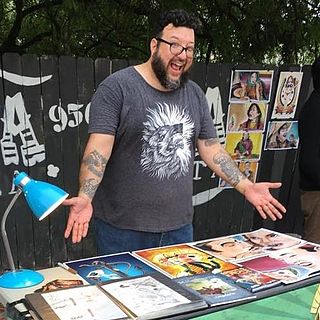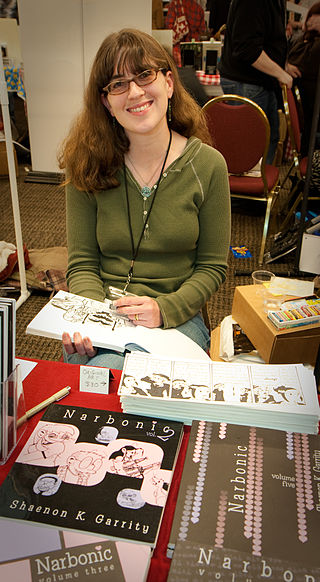
Dilbert is an American comic strip written and illustrated by Scott Adams, first published on April 16, 1989. It is known for its satirical office humor about a white-collar, micromanaged office with engineer Dilbert as the title character. It has led to dozens of books, an animated television series, a video game, and hundreds of themed merchandise items. Dilbert Future and The Joy of Work are among the best-selling books in the series. In 1997, Adams received the National Cartoonists Society Reuben Award and the Newspaper Comic Strip Award for his work. Dilbert appears online and as of 2013 was published daily in 2,000 newspapers in 65 countries and 25 languages.
Webcomics are comics published on the internet, such as on a website or a mobile app. While many webcomics are published exclusively online, others are also published in magazines, newspapers, or comic books.
8-Bit Theater is a sprite comic, meaning the art is mainly taken from pre-existing video game assets, created by Brian Clevinger that ran from 2001 to 2010 and consisting of 1,225 pages. The webcomic was, at times, one of the most popular webcomics, and the most popular sprite comic.

Achewood is a webcomic created by Chris Onstad in 2001. It portrays the lives of a group of anthropomorphic stuffed toys, robots, and pets. Many of the characters live together in the home of their owner, Chris, at the fictional address of 62 Achewood Court. The events of the strip mostly take place in and around the house, as well as around the town of Achewood, a fictional suburb.
Dinosaur Comics is a constrained webcomic by Canadian writer Ryan North. It is also known as "Qwantz", after the site's domain name, "qwantz.com". The first comic was posted on February 1, 2003, although there were earlier prototypes. Dinosaur Comics has also been printed in three collections and in a number of newspapers. The comic centers on three main characters, T-Rex, Utahraptor and Dromiceiomimus.
Bob and George was a sprite-based webcomic which parodied the fictional universe of Mega Man. It was written by David Anez, who at the time was a physics instructor living in the American Midwest. The comic first appeared on April 1, 2000, and ran until July 28, 2007. It was updated daily, with there being only 29 days without a comic in its seven years of production and with 2568 comics being made altogether.

VG Cats is a webcomic written and drawn by Canadian cartoonist Scott Ramsoomair. Published on its own website, it follows the adventures of a pair of anthropomorphic cats, who both have an interest in video games, and often play the roles of characters in popular games that are parodied in the strip.

Cayetano 'Cat' Garza is a comic artist, cartoonist, illustrator, and musician in the United States. He is best known for his experiments with webcomics.

Scary Go Round is a webcomic by John Allison. Running from 2002 to 2009, it is set in the fictional North Yorkshire town of Tackleford and follows university students battling fantasy and science fiction threats to the town. The comic was a successor to Allison's first comic, Bobbins, and was followed by Bad Machinery, all of which take place in the same general setting.

Shaenon K. Garrity is an American webcomic creator and science-fiction author best known for her webcomics Narbonic and Skin Horse. She collaborated with various artists to write webcomics for the Modern Tales-family of webcomic subscription services in the early 2000s, and write columns for various comics journals. Since 2003, Garrity has done freelance editing for Viz Media on various manga translations.

David M Willis is an American web cartoonist currently living in Columbus, Ohio. He is best known for his interconnected series of webcomics Roomies!, It's Walky!, Shortpacked!, and Dumbing of Age. Willis is also known online for his chatrooms and forums including "ItsWalky". KUTV in Salt Lake City calls him a satirist who is "a little bit edgy."

Saturday Morning Breakfast Cereal (SMBC) is a webcomic by Zach Weinersmith. The gag-a-day comic features few recurring characters or storylines, and has no set format; some strips may be a single panel, while others may go on for ten panels or more. Recurring themes in SMBC include science, research, superheroes, religion, romance, dating, parenting and the meaning of life. SMBC has run since 2002 and is published daily.
Multiplex is a comedy webcomic written and drawn by Gordon McAlpin which ran from 2005 to 2017. The comic focuses on the lives of the staff of the Multiplex 10 Cinemas and the movies that play there. Originally envisioned as an animated short, Multiplex is visually inspired by cut paper animation and vector graphics. Three print collections of the webcomic were released from 2010 to 1017. McAlpin's webcomic ended in April 2017, and the series is to be rebooted in the form of a stand-alone animated film, titled Multiplex 10.

Zachary Alexander Weinersmith is an American cartoonist and writer, best known for his webcomic Saturday Morning Breakfast Cereal (SMBC). Outside of SMBC, he has worked on a sketch comedy series, a podcast, and multiple other webcomics. With his wife Kelly Weinersmith, he has co-authored the 2017 book Soonish and the 2023 book A City on Mars. He illustrated the 2019 book Open Borders by economist Bryan Caplan, and wrote the 2023 children's book Bea Wolf, a loose adaptation of Beowulf.
The New Adventures of Queen Victoria is a daily webcomic created by Pab Sungenis. It uses the photo-manipulation technique popularized by Adobe Photoshop and other image editing programs to insert actual photographs and paintings of the characters into situations, instead of more conventional methods. It was syndicated online by GoComics, a division of Andrews McMeel Universal, and has been collected into six trade paperback editions.

Eric Millikin is an American artist and activist based in Detroit, Michigan, and Richmond, Virginia. He is known for his pioneering work in artificial intelligence art, augmented and virtual reality art, conceptual art, Internet art, performance art, poetry, post-Internet art, video art, and webcomics. His work is often controversial, with political, romantic, occult, horror and black comedy themes. Awards for Millikin's artwork include the Pulitzer Prize and Emmy Award.
The history of webcomics follows the advances of technology, art, and business of comics on the Internet. The first comics were shared through the Internet in the mid-1980s. Some early webcomics were derivatives from print comics, but when the World Wide Web became widely popular in the mid-1990s, more people started creating comics exclusively for this medium. By the year 2000, various webcomic creators were financially successful and webcomics became more artistically recognized.
Notable events of 2002 in webcomics.
Notable events of 2012 in webcomics.












